Last Updated on July 10, 2025 by Owen McGab Enaohwo

Feeling overwhelmed by the complexity of policy writing? Need help communicating your ideas effectively and bringing clarity to the chaos? Fear not! Our comprehensive guide is here to ease your pain and equip you with the tools you need to master the art of policy writing.
Policies help promote consistency and productivity while fostering an organized working environment. From startups to well-established industry giants, the unique art of policy writing is a highly underestimated skill.
Well-crafted policies are key to unlocking your workforce’s potential and fostering a positive organizational culture. This article highlights the key steps and best practices for creating comprehensive policies that your fantastic workforce can easily embrace. These policies will embody your organization’s vision and values and breathe some life into your pursuit of excellence. You can sign up to SweetProcess right now to create yours!
Table of Contents
Writing the Policy: A Step-by-Step Guide
How to Use SweetProcess for Policy Writing
Getting Started With Policy Writing: How to Prepare
Policy Writing Tips and Best Practices
Policy Writing Samples to Learn From
Guidelines For Writing the Policy

Here’s the step-by-step guide for writing the policy.
Step 1: Perform internal research
Thorough internal research is essential before creating policies. Understand the organization’s mission, values, and objectives. Identify existing policies to avoid duplication or contradictions.
Review relevant data, statistics, and past incidents to grasp the context and potential risks associated with the policy you plan to create. Engage with relevant stakeholders, such as department heads and employees, to gather insights and consider their needs.
Step 2: Identify the policies you want to create
Based on the research, identify the policies that need to be established or updated. Categorize them into clear and distinct areas, such as human resources, cybersecurity, data protection, or workplace safety. Prioritize policies based on urgency, importance, or legal requirements. Start with critical policies before moving on to those of lesser significance.
Step 3: Include the key elements in the policy
Each policy should have specific elements to ensure clarity and effectiveness. These typically include:
a. Policy Purpose and Scope
Clearly state the policy’s purpose and define its scope. Explain why the policy is essential and who it applies to within the organization. This section sets the context for the entire policy.
b. Responsibilities
Outline the roles and responsibilities of individuals or departments involved in implementing and enforcing the policy. This section helps avoid ambiguity and ensures accountability.
c. Policy Statement
Present the policy’s primary principles and rules concisely. Use clear language to avoid misinterpretation and make it easy for readers to understand.
d. Procedures and Guidelines
If necessary, include detailed procedures or guidelines that help employees adhere to the policy effectively. Use bullet points or numbered lists to improve readability.
e. Compliance and Consequences
Explain the consequences of policy violations and the organization’s steps to ensure compliance. This section emphasizes the policy’s importance and encourages adherence.
Step 4: Create content for each element of the policy
For each identified policy document, develop content that addresses the key elements. Be precise and concise, and avoid ambiguous language. Use clear terminology and avoid jargon. Ensure that the policy is aligned with the organization’s culture and tone. Seek feedback from subject matter experts and relevant stakeholders to ensure accuracy and completeness.
Step 5: Add more information to clarify the policy for stakeholders
While conciseness is crucial, certain policies may require additional information or context to ensure stakeholders fully comprehend their implications. Create supplementary materials like FAQs, examples, or implementation guidelines. These supporting documents can help employees understand how the policy applies to specific scenarios, promoting better compliance.
Step 6: Revise, review, and format the policy
Once the initial draft is ready, conduct a thorough review. Look for inconsistencies, ambiguities, or potential gaps in the policy. Seek feedback from different departments and levels of the organization to gain diverse perspectives. Revise the policy accordingly and ensure it aligns with the organization’s language and style.
Consider formatting the policy in a user-friendly manner. Use headings, bullet points, and numbering to enhance readability. Employ a logical flow that makes it easy for readers to navigate the policy.
Step 7: Approve and publish
Before finalizing the policy, obtain necessary approvals from relevant stakeholders or management. Ensure that all changes and feedback are incorporated into the final version. Once approved, communicate the policy effectively to all employees and relevant parties. To ensure maximum visibility, use multiple channels such as emails, internal communication apps, intranet, or company-wide meetings.
How to Use SweetProcess for Policy Writing
SweetProcess is a powerful tool that can streamline and simplify the process of policy writing and management for businesses and organizations. This section will explore three aspects of using SweetProcess: manual policy writing, automatic policy generation with SweetAI, and the management of existing policies.
We will provide step-by-step instructions, screenshots, and video walkthroughs to help you understand how to use SweetProcess effectively.
Using SweetProcess to Write a Policy Manually
You may decide to write your policy manually using SweetProcess. Our SOP software offers a user-friendly interface that makes the process seamless.
Step 1: Log in to SweetProcess
Create a new SweetProcess account if you don’t have one before now, or log in to the account if you already have one.
Once logged in, you’ll be taken to the dashboard; click the “Policies” tab.

Step 2: Create a New Policy

Click the “+ Create Policy” button to create a new policy.
Give the policy a title.

Add the policy to one of your teams or more.
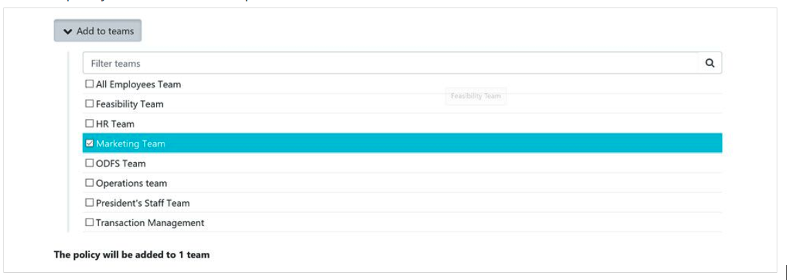
Click the “Continue” button.

Click on the space beneath to edit the policy.

Step 3: Define Policy Steps
Click on the “Add Step” button to add the first step to your policy.
Give the step a title and a brief description that explains what it entails.
You can also add images, videos, or documents to clarify the step further.
Step 4: Review and Publish
Review your policy once you’ve completed all the necessary steps.
When drafting the policy document, click “Approve” in the upper right corner of the page to approve it and make it live.

You can request permission by clicking the “Request Approval” button, as shown below, even if you cannot approve the policy.

Note: Any process or policy you create in SweetProcess may be embedded on any website you choose, and any changes you make will be instantly updated.
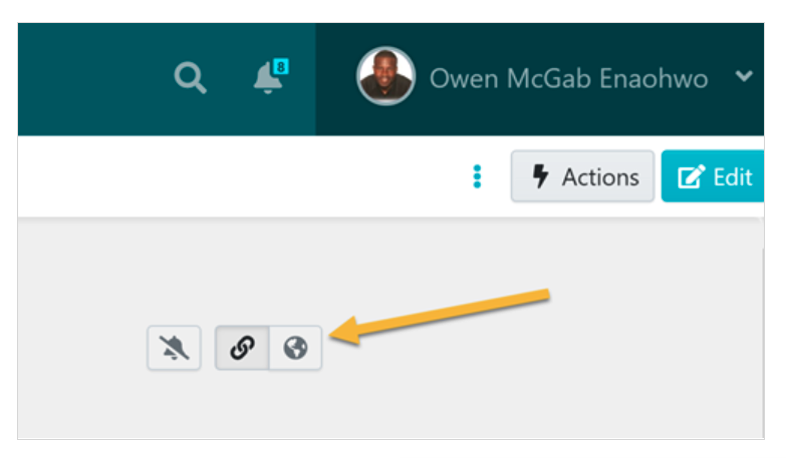

Using SweetAI to Generate Policies Automatically
SweetProcess offers an exciting feature called SweetAI, which utilizes artificial intelligence to automate policy writing based on predefined templates and guidelines. You may generate your policies in five easy steps.
Step 1: Click on the “Policies” tab on the dashboard

Step 2: Click on the “Create Policy” button

Step 3: Enter the title of the policy

Step 4: Select “Write with SweetAI”

Step 5: Manual Review and Editing
Even though SweetAI does an excellent job of drafting a policy automatically, manual review and editing are essential to ensure accuracy and relevance.
Make all necessary changes to the policy before publishing. Find below a video guide on using SweetAI:
Note: One sweet feature of SweetAI is its ability to suggest policies and procedures for you based on your industry.

This makes your work easier and saves you the hassles of thinking through policies required for your industry.
In addition to writing policies, we explain how to edit a policy using AI in this in-depth guide.
What Exactly Is a Policy?
Policies are like guidelines that define how every employee should act and make decisions. It involves staying consistent, following the organization’s rules or regulations, and staying true to its goals. These policies highlight several issues, including employee behavior, how crucial data should be handled securely, how finances should be managed, and more. You know, all that good stuff!
Setting up policies makes them serve as guiding lights for all employees, ensuring they know what is expected of them. This helps create a friendly work environment. Plus, they help manage risks and legal stuff, keeping everything in check.
These policies are penned down or typed, printed, and shared with every employee involved. This places all employees on the same page. However, the business world is always dynamic; therefore, these policies require regular reviews and updating to stay effective.
Bottom line: Policies are like the compass determining how things should be done in an organization. They are created to ensure everyone’s on track and completes their tasks correctly. It’s all about keeping things organized and productive for everyone.
Why Is Policy Writing Important for Your Company?

Policy writing is crucial for your company for several reasons. Firstly, company policies are the rules or guidelines that determine the behaviors of employees. According to the U.S. Justice Department, a company needs rules and procedures to fulfill the requirements of an efficient compliance program. Clear policies promote a positive work environment by reducing misunderstandings and conflicts.
Secondly, policies help mitigate risks and ensure compliance with laws and regulations. By outlining procedures and protocols, employees can safeguard the company from legal liabilities and potential financial losses.
Effective policy writing also enhances organizational efficiency. Understanding an organization’s expectations from employees is like the secret sauce to success. This helps streamline processes and reduces the need for constant supervision.
Furthermore, policies contribute to building a reputable brand image. They demonstrate employees’ commitment to ethical practices, data privacy, and safety, fostering trust with customers and stakeholders.
Lastly, policies aid in adapting to changing circumstances. Reviewing and updating policies regularly enables employees to stay current with industry trends while ensuring the organization stays highly responsive to evolving challenges.
Policy writing is essential for creating a harmonious, compliant, and successful business environment.
Using SweetProcess to Manage Policies
After creating policies, managing them efficiently is vital to keep them up-to-date and ensure organizational compliance. Managing your policies is very easy with SweetProcess. The platform is flexible and allows for edits and updates.
Step 1: Select the policy you wish to edit

Step 2: Click the “Edit” tab to edit the policy.
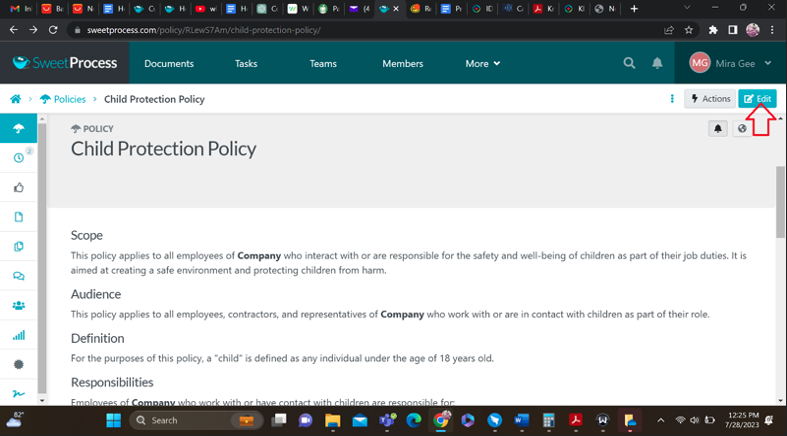
Step 3: Click on the “Actions” tab on the top right corner of your screen if you intend to perform other actions
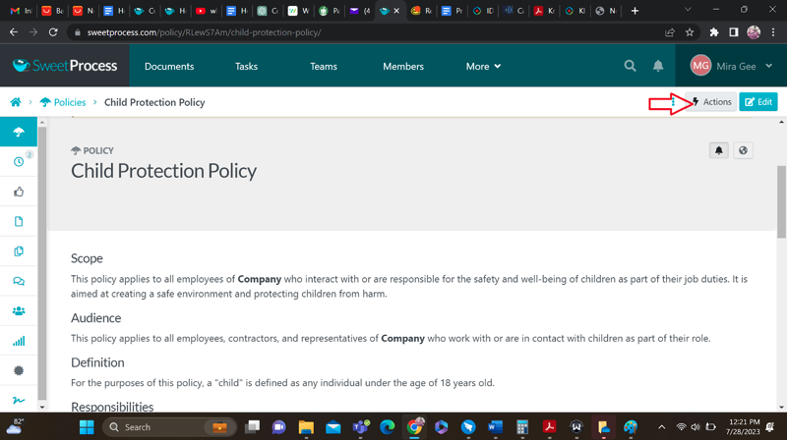
Step 3: Select from the drop-down the action you wish to perform
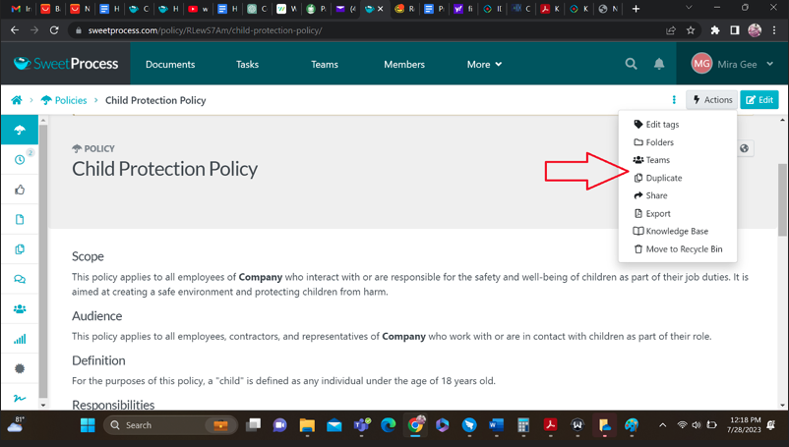
You may edit tags, add to folders, teams, or export.
Success Stories

Some of SweetProcess’s customers have expressed satisfaction with using SweetProcess to create, implement, and manage policies. Notable among them are as follows.
TechQuarters, a dynamic technology solutions provider, recognized the challenges posed by tribal knowledge within its organization. Tribal knowledge refers to information and expertise known to only a few individuals, making it difficult to share and retain vital information across the team. TechQuarters implemented SweetProcess, a powerful process documentation and management tool, to address this issue and enhance operational efficiency.
Using SweetProcess, TechQuarters successfully eliminated the reliance on tribal knowledge and created a more organized, efficient, and collaborative work environment. They now enjoy seamless policy documentation and sharing. The company empowered its team members with the information they needed to excel in their roles, resulting in increased productivity, enhanced knowledge retention, and improved overall performance.
Clients have continuously achieved tremendous results with SweetProcess. Another such client is Michel Coutu, the president of Location Accès Crédit. Location Accès Crédit helps clients access vehicle loans in Canada. Michel needed help with his employees following stipulated work policies. His major pain point was the need for more documentation. His employees needed help accessing work-related policies.
In his search for a solution, he found SweetProcess, where he could document his policies and ensure adherence. Since then, Location Accès Crédit has enjoyed standardized business operations, seamless employee onboarding and training, and remote access to work documents.
Next7 IT, a leading IT services company, recognized the need for greater consistency in its operations to deliver top-notch services and solutions to its clients. Next7 IT implemented SweetProcess to address this challenge and streamline its processes. By leveraging SweetProcess, the company achieved significant improvements in consistency throughout its operations.
In summary, Next7 IT achieved greater operational consistency by leveraging SweetProcess as a powerful process management tool. The platform helped the company standardize procedures, improve communication, enhance collaboration, and optimize performance, ultimately leading to more reliable and exceptional service delivery for its clients.
To experience seamless workflow and manage your policies effectively, sign up for a 14-day free trial to learn more about our services.
Pros and Cons of Writing a Policy
Writing a policy has some benefits as well as drawbacks you should know. This section discusses the pros and cons of policy writing, arranged in no particular order.
Pros of Policy Writing
Clarity and Consistency: Policies generally provide crystal-clear guidelines or rules that help ensure consistency when making crucial decisions or taking certain actions within an organization. When everyone knows and follows the policies, it reduces confusion and promotes a unified approach to various issues.
Legal Compliance: Well-written policies help organizations comply with legal and regulatory requirements. They can address specific legal obligations, industry standards, and ethical considerations, reducing the risk of legal disputes and penalties.
Risk Management: Policies play a crucial role in mitigating risks, including security, safety, financial, and data protection. Integrating a business continuity plan within policy writing ensures organizations remain prepared for unforeseen disruptions, safeguarding critical processes and operations.
Accountability and Transparency: Policies set the expectations and standards for an organization’s responsibilities, roles, and behavior. They excellently promote accountability among employees while ensuring transparency in every decision-making process.
Efficient Decision-Making: Policies establish a pretty solid framework for decision-making. Managers, as well as employees, make quick and highly informed choices confidently using policies.
Employee Guidance: Policies provide workers with a reference point for their benefits, rights, and obligations within the company. They can address issues like leave policies, performance evaluations, and grievance procedures, helping to create a positive and supportive work environment.
Organizational Culture: Policies can reflect the organization’s values and promote a positive culture. They support workplace diversity and inclusion efforts, ethical conduct, and other initiatives that align with the organization’s mission and vision.
Resource Allocation: Policies can help allocate resources effectively by defining priorities and providing guidelines for resource distribution. This ensures that resources are utilized productively and strategically.
Conflict Resolution: When conflicts arise within an organization, policies are the reference point for resolving all disputes objectively and impartially. This prevents favoritism or bias during decision-making.
Adaptability and Growth: Policies are generally not set in concrete or stone. They evolve as the organization expands or grows over time. Regularly reviewing and updating policies allows organizations to adapt to new challenges and opportunities.
Stakeholder Confidence: Policies enhance the utmost confidence of company stakeholders, such as partners, investors, and customers, as they demonstrate that the organization functions with structured and responsible approaches.
Cons of Policy Writing
Policy writing has its share of challenges. Some of the cons of policy writing include the following:
Complexity and Length: Policies often require detailed explanations and can be lengthy, leading to potential confusion for employees or stakeholders needing help understanding the policy’s intricacies.
Bureaucracy: The policy development process can be bureaucratic and time-consuming. Multiple levels of approval, revisions, and consultations may slow down the implementation of necessary policies.
Lack of Clarity: Poorly written policies may result in confusion, misinterpretation, and ineffective implementation, undermining the policy’s goals.
Resistance to Change: Employees may resist new policies, especially if they perceive them as burdensome or constraining. Resistance can hinder effective implementation and adherence.
Responsibilities of Policy Owners

The policymaker has several key responsibilities to ensure the effective implementation and adherence to organizational policies. These responsibilities are crucial for maintaining a compliant working environment.
Here are the primary duties of policy owners:
Policy Development: Policy owners are accountable for creating and formulating new or updated policies. They must conduct thorough research, gather relevant information, and involve relevant stakeholders to ensure policies are comprehensive and aligned with the organization’s goals.
Policy Communication: Policy owners are responsible for effectively communicating policies to all relevant parties. They must ensure employees understand the policies, purpose, and implications. Clear communication helps minimize misunderstandings and ensures consistent adherence throughout the organization.
Implementation: Policy owners play a pivotal role in implementing policies effectively. They must collaborate with various departments to seamlessly integrate policies into their workflows and operations.
Compliance Monitoring: Regularly monitoring policy compliance is crucial to identify deviations or potential issues. Policy owners should establish mechanisms for tracking adherence and conduct periodic reviews to assess the effectiveness of policies.
Training and Education: Policy owners must provide employees with adequate training and educational resources to ensure successful implementation. This helps raise policy awareness and equips staff members with the knowledge and skills to follow them.
Documentation: Properly documenting policies, their development process, and any changes made are essential. Policy owners should maintain comprehensive records to track the policy lifecycle and facilitate auditing and reporting.
Revisions and Updates: Policies should be revised and updated over time. This is essential so they reflect the prevailing changes in organizational requirements. Policy owners should go through them regularly. If needed, give those policies a little shake-up to match the latest trends and changes.
Getting Started With Policy Writing: How to Prepare

Policy writing is crucial to any organization or business. To start writing policies, here are some significant do’s and don’ts, including things you should consider before writing your organization’s policy.
Do’s and Don’ts of Policy Writing
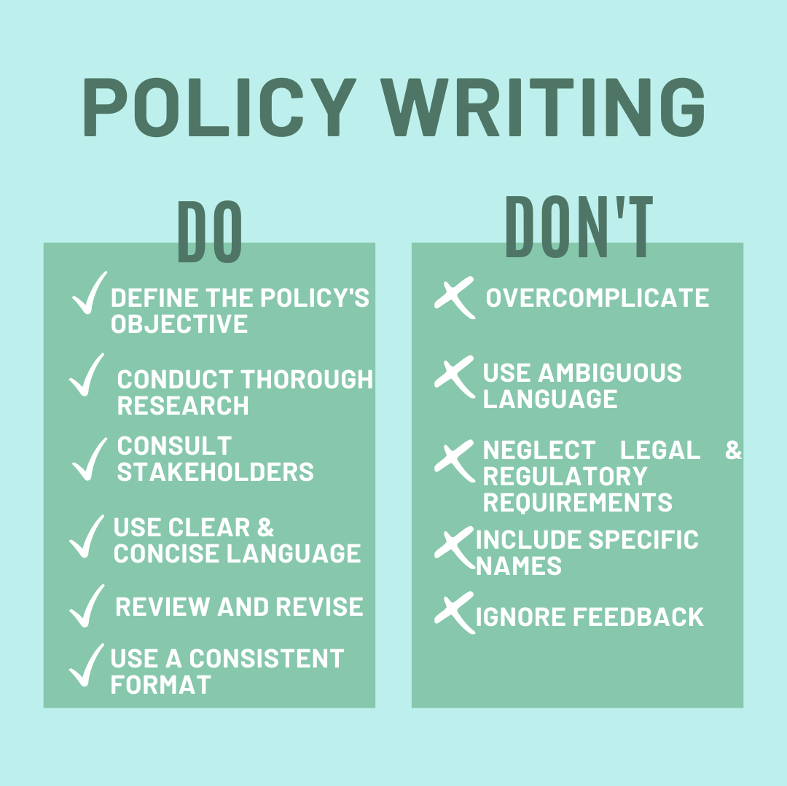
What to Consider Before Writing a Policy

Before writing a policy for your organization, you need to consider the following:
Policy Objective: Clearly outline the primary goal of the policy. What problem does it seek to address? What outcomes are expected?
Scope and Applicability: Define the scope of the policy—which departments, processes, or individuals does it cover? Determine whether it applies organization-wide or to specific divisions.
Communication and Training: Plan how the policy will be communicated to employees and stakeholders. Consider providing training to ensure understanding and compliance. A work instruction template can help standardize training materials, making it easier for employees to follow step-by-step procedures and adhere to company policies effectively.
Timeline: Set clear timelines for policy implementation, review, and updates.
Resources and Implementation: Consider the resources required for effective policy implementation, including training, technology, and personnel.
Risks and Impact Assessment: Evaluate the potential risks associated with the policy and assess its impact on different stakeholders.
Legal and Regulatory Compliance: Ensure the policy aligns with relevant laws, regulations, and industry standards.
Guidelines for Writing a Policy
The following are the guidelines you should follow when writing a policy for your organization:
● Title: Choose a clear, descriptive title reflecting the policy’s purpose.
● Policy Statement: Begin with a policy brief statement that clearly states the purpose and objectives of the policy.
● Definitions: Include a section that defines any specific terms or concepts used in the policy.
● Policy Content: Present the policy in a logical and organized manner. Use headings and subheadings to break down complex sections.
● Responsibilities: Clearly outline the responsibilities of individuals or departments involved in implementing and enforcing the policy.
● Procedures: If necessary, include detailed procedures or steps for compliance.
● Review and Approval: Specify the process for policy review, approval, and any amendments.
● Formatting and Accessibility: Ensure the policy is presented consistently and is easily accessible to all relevant parties.
Policy Writing Tips and Best Practices
A well-structured policy document is crucial for clear communication and effective implementation. It should begin with a concise title that reflects the policy’s purpose.
Format of a policy document
A standard policy typically consists of the following sections:
● Introduction: Provides an overview of the policy’s intent and importance.
● Scope: Defines the boundaries and applicability of the policy.
● Policy Statement: Clearly states the policy’s objectives and the expected behavior or actions.
● Procedures: Describes the step-by-step process for compliance or implementation.
● Responsibilities: Outlines the roles and duties of individuals or departments involved.
● Compliance and Enforcement: Specifies consequences for non-compliance and mechanisms for enforcement.
● Definitions: Clarifies any technical terms or jargon used in the policy.
● References: Includes citations to laws, regulations, or other relevant policies.
● Revision History: Include a record of changes made to the policy over time.
● Contact Information: Provide details for individuals or departments that can address questions or concerns related to the policy.
Design and Layout of a Policy Document
Having gotten the format correctly, the next thing is to design the policy document. A well-designed policy document should be:
● Clear and Readable: Use a legible font, appropriate font size, and ample white space to enhance readability.
● Organized: Utilize headings, subheadings, and bullet points to break down information into manageable sections.
● Consistent: Maintain a uniform format throughout the document for a professional look.
● Visually Appealing: Incorporate relevant images, graphs, or charts to illustrate key points and make the document engaging.
● Accessible: Ensure the document can be easily accessed in various formats, including digital and print.
● Branding: Adhere to the organization’s branding guidelines, including color schemes and logos.
● Table of Contents: Include a highly detailed table of contents for easy navigation.
Writing Style for a Policy
What writing style should you adopt? Writing style is crucial to ensure policy documents are understandable and user-friendly. There are different writing styles, but ensure that whichever you choose, take note of the following.
● Use simple and unambiguous language. Avoid passive voice, jargon, and technical terms when possible.
● Write formally, maintaining a consistent voice throughout the document.
● Be precise, leaving no room for interpretation.
● Use short sentences and paragraphs; keep them concise.
● Use active voice to make the document more direct and engaging.
● Address the audience directly, using words like “you” and “your” to convey responsibilities.
● Be inclusive and considerate of diverse audiences.
More Policy Tips and Best Practices
● Involve relevant stakeholders in policy development to gain valuable insights and ensure buy-in.
● Regularly review and update policies to align with changing laws, regulations, and organizational needs.
● Ensure consistency across all policies within the organization.
● Provide training and resources to help employees effectively understand and comply with policies.
● Use real-life examples or scenarios to illustrate policy application.
● Make the policy accessible by publishing it on internal platforms or intranet sites.
● Implement a feedback mechanism for employees to raise questions or seek clarifications regarding the policy.
● Consider seeking legal advice and review for critical policies, to ensure compliance with all applicable laws and regulations.
Following these policy writing tips and best practices will result in well-structured, user-friendly, and effective policies that support organizational goals and ensure compliance.
Implementing Your New Policy

Implementing a new policy within an organization involves three key steps: policy implementation, policy compliance management, and considerations related to policy legalities.
Let’s explore each of these aspects:
Policy Implementation Process
● Policy Development: This is the stage where the policy is formulated. It involves identifying the need for a new policy, conducting research, and involving relevant stakeholders in its creation.
● Policy Documentation: The policy must be documented clearly, outlining its purpose, scope, objectives, and the responsibilities of individuals and departments involved in its implementation.
● Communication: Once the policy is finalized, it is crucial to communicate it effectively throughout the organization. This includes sharing the policy document, providing training sessions or workshops, and ensuring all employees understand the policy’s importance and implications.
● Resource Allocation: Adequate resources must be allocated to implement the policy successfully. This may include budgetary considerations, personnel, and technological resources.
● Piloting and Testing: In some cases, piloting the policy in a smaller, controlled environment to identify any potential issues or areas of improvement before a full-scale implementation is beneficial.
● Rollout: The policy is officially launched across the organization, and all relevant parties are expected to adhere to it.
● Policy Review and Updates: Policies should be reviewed periodically, and updates may be required to keep them aligned with changing circumstances, regulations, or organizational needs.
Policy Compliance Management
● Training and Education: Employees should receive proper training and education on the policy’s requirements and implications to ensure they understand their responsibilities and the importance of compliance.
● Monitoring and Auditing: Regular monitoring and auditing—i.e., internal and external assessments—should be established to assess compliance levels.
● Enforcement and Consequences: A clear framework for enforcement and consequences for non-compliance should be established. This could range from corrective actions and retraining to disciplinary measures, depending on the severity of the breach.
● Continuous Improvement: Based on monitoring and feedback, adjustments to the policy or compliance management processes should be made to improve effectiveness. Remember that your organization may be liable for outdated or inconsistently enforced policies.
Policy Legalities
● Legal Review: Before implementing a policy, it is of utmost importance to scrutinize it thoughtfully by seasoned legal experts. This prudent step ensures its complete adherence to all applicable laws, regulations, and industry standards.
● Risk Evaluation: Embark on a comprehensive risk assessment journey to identify potential legal pitfalls entwined with the policy. Armed with these insights, policy owners can deftly navigate the landscape and apply appropriate measures to mitigate such risks effectively.
● Privacy and Data Protection: Should the noble policy encompass the handling of sensitive data, it becomes essential to uphold relevant data protection and privacy laws dutifully. Safeguarding the personal information entrusted to any organization is a sacred responsibility to embrace.
● Employee Rights: The policy should exquisitely respect the inherent rights of every valued employee. No provision should infringe upon employment laws or collective bargaining agreements, fostering an environment of harmony and mutual understanding.
● Public Policy Considerations: Policies should align with broader public policy objectives and not conflict with societal norms or values.
● It’s crucial to involve relevant stakeholders from the early stages of policy development to ensure buy-in and cooperation.
Policy Writing Samples to Learn From
Below are some policy writing samples that can be examples for readers.
[Your Organization Name]
[Policy Name]
Version: [Version Number]
Effective Date: [Effective Date]
Last Updated: [Last Updated Date]
[Policy Introduction]
[Briefly explain the purpose and scope of the policy. Describe the key goals and objectives it aims to achieve.]
[Policy Section 1]
[Policy Description]
[Provide a detailed explanation of the policy, including the rules, guidelines, or standard operating procedures that employees, contractors, or other relevant parties must follow. Use clear and concise language to ensure easy understanding.]
[Policy Compliance]
[State the consequences of non-compliance with the policy. This may include disciplinary actions or penalties.]
[Policy Responsibilities]
[Clearly outline the roles and responsibilities of individuals or departments involved in implementing the policy. This section should identify who is accountable for ensuring compliance and enforcing the policy.]
[Policy Section 2]
[Repeat the structure for each subsequent policy section, as needed.]
[Policy Review and Updates]
[Explain the process for reviewing and updating the policy. Include information about how often the policy will be reviewed, who is responsible for updates, and how changes will be communicated to the relevant stakeholders.]
[Policy Approval]
[List the individuals or departments that have approved the policy. Include names, positions, and dates of approval.]
[Policy Acknowledgment]
[Mention how employees or relevant parties must acknowledge and understand the policy. This may involve signing a form or completing an acknowledgment process.]
[Contact Information]
[Provide contact details for individuals or departments that employees can contact if they have questions or need clarification about the policy.]
[Policy Document Control]
[Explain how the policy will be stored, accessed, and version-controlled to ensure the most current version is readily available to all relevant parties.]
[Policy Related Documents]
[List any related documents, procedures, or guidelines employees should refer to when implementing the policy.]
[Policy Revision History]
[Keep a log of changes made to the policy, including version numbers, dates of updates, and brief descriptions of changes. Make sure to follow your organization’s existing style guide and formatting standards.]
These policy writing samples and case studies demonstrate the versatility and efficiency of SweetProcess in managing policies effectively across various organizations and scenarios.
Template for Writing a Policy
SweetProcess offers you a free policy templates handbook. This contains 53 policy and procedure templates. However, here is an excellent template for writing a policy:
[Your Organization/Company Name]
[Policy Name]
[Policy Number]
Effective Date: [Date]
Policy Statement
[Provide a clear and concise statement outlining the policy’s purpose and intent. This statement should define the scope of the policy and the desired outcomes.]
Purpose
[Explain the rationale behind the policy and its significance within the organization. Describe why the policy is implemented and how it aligns with the organization’s goals and values.]
Scope
[Specify the extent and boundaries of the policy. Define who or what the policy applies to within the organization. Mention any exceptions or exclusions if applicable.]
Policy Details
[Present the specific policy details in a clear and organized manner. Use bullet points or numbered lists to break complex information into easily understandable sections.]
4.1. [Policy Subsection 1]
[Explain the first aspect or subsection of the policy. Include any rules, guidelines, or procedures related to this subsection. Provide clear instructions on how to comply with the policy manual.]
4.2. [Policy Subsection 2]
[Explain the second aspect or subsection of the policy. Repeat the same format as above, providing clear instructions and guidelines for compliance.]
4.3. [Policy Subsection 3, and so on…]
[Continue with additional subsections as necessary.]
Responsibilities
[Outline the responsibilities of different individuals or organizational roles regarding implementing, enforcing, and monitoring the policy.]
5.1. [Role 1]
[Specify the responsibilities of the first role and how they contribute to the policy’s effectiveness.]
5.2. [Role 2]
[Specify the responsibilities of the second role and how they contribute to the policy’s effectiveness.]
5.3. [Role 3, and so on…]
[Continue with additional roles and their corresponding responsibilities.]
Compliance
[Explain the steps individuals or entities must take to comply with the policy. Include information about reporting mechanisms, training requirements, and any potential consequences for non-compliance.]
Review and Revision
[Describe the process and frequency of policy review to ensure it remains up-to-date and effective. Specify who is responsible for conducting the review and any mechanisms for seeking stakeholder feedback.]
Approval
[Indicate the names and titles of individuals or bodies responsible for approving the policy. Include the date of approval.]
Related Policies
[List any other relevant policies related to or impacted by this policy. Provide references and cross-links to these policies if available.]
Contacts
[Provide contact information for individuals or departments that can answer questions or provide assistance regarding the policy.]
[Include any necessary attachments or appendices that support the policy, such as forms, guidelines, or legal references.]
Remember to tailor the policy template to your organization’s needs and requirements while maintaining clarity and coherence throughout the document.
Final Thoughts
Do you want to avoid grappling with disorganized policies that lead to confusion and inefficiency within your organization? It’s time to streamline your operations and drive success with SweetProcess. Take the first step toward a more organized and thriving business. Sign up for SweetProcess today and witness its positive impact on your organization’s growth and prosperity. Your path to streamlined success awaits.
Frequently Asked Questions

What does a company policy look like?
A company policy’s specific content and structure may vary depending on the organization’s size, industry, and specific needs. However, here are some common elements in a typical company policy: policy title, statement, scope, definitions, objectives, responsibilities, procedures, compliance, and reporting mechanisms.
What is the difference between a policy and a procedure?
A policy guides an organization, setting goals and direction with clarity. A procedure outlines specifics and provides roadmaps for tasks. Combining policies and procedures ensures streamlined operations and consistency, effectively propelling the company toward its goals.
How long should a policy be?
The length of a good policy should be concise and clear, focusing on conveying essential information. Avoid unnecessary details and use straightforward language to ensure comprehension. Aiming for one to five pages is generally ideal, but it ultimately depends on the complexity and scope of the policy.

